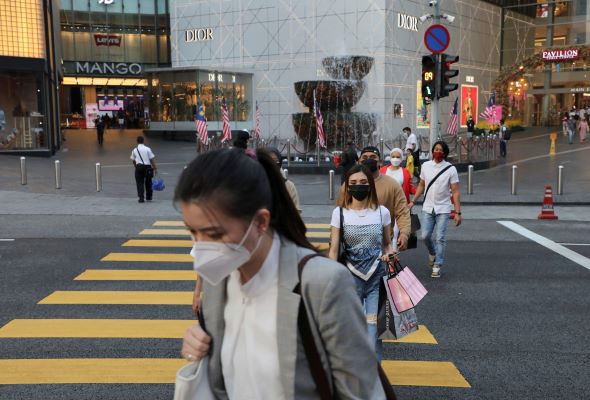
Published in Malay Mail, Focus Malaysia, theSundaily, New Straits Times & Asia News Today, image by Focus Malaysia.
The Sarawak state election could well determine the course for the general election (GE) due by 2023. The GE might be held sooner rather than later depending on the nature of the results.
Coming after the Sabah state election (2020) and Melaka state election (2021), the Sarawak state election will witness a total of 82 state seats contested on December 18, 2021 as the polling day.
Although the Election Commission (EC) allows ceramahs to be organised in areas with limited internet connectivity during the campaign period, Sarawakians, in general, might not be motivated to go out to vote.
Part of the reason is due to the new Omicron variant that emerged globally during recent weeks.
The Melaka state election that was concluded few weeks ago (i.e., November 21) showed an overall voter turnout of 65.85%, below the EC’s forecasted target of 70%.
Even with Undi18 and automatic voter registration coming into effect on December 15, Sarawakians aged 18 to 20 this year still would not be able to discharge their civic rights in this Sarawak state election.
Datuk Seri Wan Junaidi Tuanku Jaafar, the Minister in the Prime Minister’s Department in charge of Parliament and Law, indicated that the implementation of the Constitution (Amendment) Act 2019 reducing the voting age from 21 to 18 will begin from January 2022. Therefore, the 12th Sarawak state election will be based on the electoral roll that was passed before the dissolution of the State Legislative Assembly on November 3.
As Sarawakians based in the Peninsula would be unlikely to make logistical arrangements to return to Sarawak one week before Christmas, Sarawak might experience a lower voter turnout – lower than 65%.
Like many Sabahans and Melakans, localised Sarawakians appear to be more concerned about bread-and-butter issues such as cost of living, employment and income over who will form the next state government.
Based on the 12th Malaysia Plan (12MP), Sarawak recorded the lowest gross domestic product (GDP) growth compared with other states – at merely 0.9% per annum between 2016 and 2020. The economic performance of Sarawak during the past five years is lower than the national average of 2.7% per annum.
The on-and-off inter-state travel ban and continuous closure of international borders for over two years have forced many businesses in Sabah, Melaka and Sarawak to shutter temporarily or permanently.
Put it simply, the lockdowns had dealt a devastating blow to these micros and small businesses.
Such a phenomenon is reflected particularly in the city centres of Kota Kinabalu and Kuching as well as the famous Jonker Street in Melaka. The shutters were down for most of the sea and land tour agencies, and some even displayed signs that the shop lots were available for rent.
As a result, the spending multiplier (i.e., the spending effect) of tourists which goes beyond the immediate local tourism hotspots or sites have become almost non-existent. This means that businesses especially the micros and small ones that rely on tourism receipts also have lost a critical income stream or source.
The drastic fall of domestic tourists in three Malaysian states between 2019 and 2020 could have well contributed to the increase in the absolute poverty rates of Melaka, Sabah and Sarawak by 2.2, 5.8 and 3.9 percentage points in 2020, respectively, as shown in Table 1.
Table 1: No. of Domestic Tourists (million) and Absolute Poverty Rate (%) in Melaka, Sabah and Sarawak, Malaysia (2019 and 2020)

Besides the ongoing Covid-19 pandemic, the low prices of crude oil, palm oil and rubber are among the factors leading to the slower economic growth in Sarawak, translating to a higher absolute poverty rate of 12.9%.
In addition, Pusa, Tebedu and Matu are among the three poorest districts in Sarawak. Compared to Bintulu’s median income of RM7,380, Pusa recorded a median income of RM2,449, followed by Tebedu (RM2,614) and Matu (RM2,776).
The number of the bottom 40% (B40) households in Sarawak had also increased from 241,500 in 2016 to 250,200 in 2019.
As most Sarawakians are involved in semi- and low-skilled jobs, this contributes to low median household income in the rural areas of Sarawak, which was RM3,195 in 2019, compared with the national average of RM3,828.
According to the 2019 Household Income and Basic Amenities Survey Report, the composition of skilled workers in Sarawak only comprises 20.3%, followed by semi-skilled workers (62.9%) and low-skilled workers (16.8%).
Furthermore, the Covid-19 pandemic exposed how vulnerable Sarawakians are when accessing roads and treated water supply as well as health, education and digital infrastructure.
Although a total of 795km of rural roads in Sarawak were constructed and upgraded in the 2016-2020 period, only 59.4% of the Pan Borneo project in Sarawak is completed.
Aside from sanitation and drainage systems, the provision of sewerage and waste disposal services in rural Sarawak remains a challenge due to the sparsely-populated areas, challenging geographical terrain and poor accessibility to project sites. State district officers still have to drive through muddy, uneven roads, besides having a boat ride to reach the remote or rural population.
A low return of investment in rural areas, high permit charges and complicated local authority procedures are issues that have eventually deterred telcos from providing digital services. A teacher from Sarawak had to lead a group of primary and secondary school students from his village in Nanga Sumpa and nearby Nanga Jambu in Lubok Antu on a jungle trek just for better internet coverage.
Also, Sarawak has a smaller distribution of doctors than on the peninsula. In 2019, the official ratio of doctors to the population in Sarawak was 1:682, lower than the national average of 1:482. A lack of medical specialists and amenities has raised the cost of healthcare.
Limited access to digital services has deprived some students based in rural Sarawak of accessing online learning materials. Moreover, the issue of dilapidated schools in Sarawak is a hindrance for students to experience a conducive teaching and learning environment.
Due to under-developed infrastructures, Sarawak continues to face enormous challenges in attracting investment for industrial development. When there is a lack of a supportive ecosystem (i.e., availability of local technology, skilled talent, efficient supply chain and attractive incentives) together with lower investment, this would result in lower GDP growth, and by extension, higher unemployment.
Sarawak continues to record a higher unemployment rate, from 3.1% in 2019 to 4.3% in 2020. Youth unemployment has become an issue among Sarawakians as well. In 2020, 12.3% of Sarawakian youths were jobless, higher than the national average of 12%.
Therefore, to restore the economic livelihoods among Sarawakians, the next Sarawak state government should consider implementing the following initiatives:
- Conduct periodic reviews (i.e., once in three months) for all short-, medium- and long-term development strategies together, ensuring all plans can be implemented within a specific timeframe;
- Work together with the private sectors in rural areas to help attract higher value investment, promote rural tourism activities and agro-tourism, enable the products to be sold via digital applications and social media, as well as enhance employability through knowledge enhancement and skills training;
- Increase crop diversification and produce high-quality agricultural products to diversify the revenue stream. Besides reducing dependence on palm oil production, Sarawak could potentially develop a major food hub with Sabah and Kalimantan to fulfil the increasing demand from major markets such as China, Singapore and Brunei;
- Federal Agricultural Marketing Authority (Fama) and related government agencies can assist rural farmers in Sarawak in transporting agricultural produce to major cities of Sarawak or for export; and
- Partner with the private sector by providing apprenticeships where its youths would have the opportunity to reskill, upskill and cross-skill besides securing a job after completion of the apprenticeship.
It is good that Sarawak will continue to receive between 15% and 18% annually of the total basic development allocation to improve infrastructure and basic facilities in Sarawak under the 12MP.
However, to realise the goal of increasing Sarawak’s annual GDP growth to 5.3%, it is time for the Sarawak state government to enhance the development potential of cities and towns in the next four years. For instance, Bintulu, Kapit, Miri and Sibu in Sarawak have their respective potential for the generation of more economic development.
In a nutshell, political parties or candidates who prioritise restoring the economic livelihoods among Sarawakians would stand a higher chance to win the upcoming Sarawak state election and thereby govern the state.
Amanda Yeo is Research Analyst at EMIR Research, an independent think tank focused on strategic policy recommendations based on rigorous research

